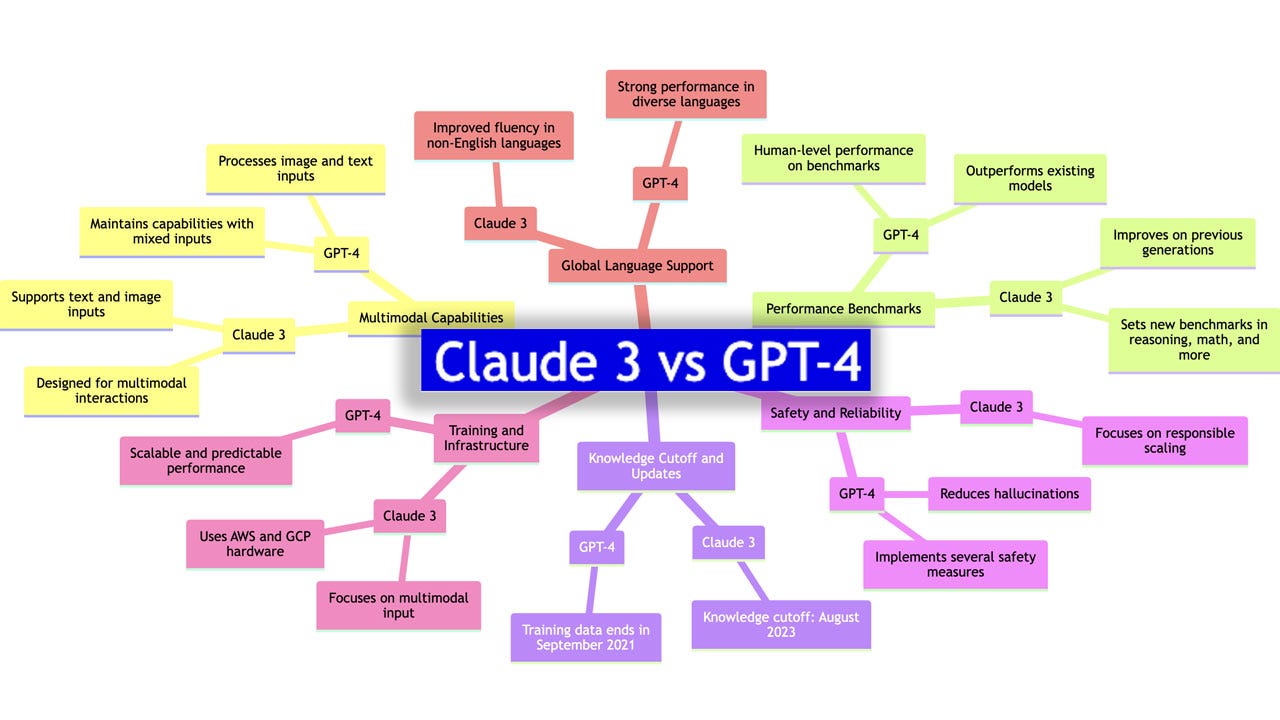It is based on the Claude 3 and GPT-4 model cards,
Here is a detailed comparison focusing on specific features of both models:
Multimodal Capabilities:
Claude 3: Supports text and image inputs, demonstrating strong performance across a variety of tasks including reasoning, math, coding, and fluency in non-English languages. Claude 3's models are explicitly designed to process and analyze image data, enabling rich, multimodal interactions.
GPT-4: Also a multimodal model capable of processing image and text inputs to produce text outputs. It shows strong capabilities in handling documents with text and photographs, diagrams, or screenshots, maintaining similar capabilities as it does with text-only inputs.
Context Window
Claude 3: The models family, which includes Claude 3 Opus, Claude 3 Sonnet, and Claude 3 Haiku, boasts a remarkable 200,000-token context window across all three models.
GPT-4: on the other hand, offers different context window sizes depending on the model variant. The standard GPT-4 model has a context window of up to 8,192 tokens, while a more advanced version, GPT-4 Turbo, significantly increases this capacity to 128,000 tokens. GPT -4 32K
Performance Benchmarks:
Claude 3: Sets new industry benchmarks in reasoning, math, coding, multi-lingual understanding, and vision quality. It significantly improves on previous generations for coding tasks and non-English languages, enabling broader global utility.
GPT-4: Exhibits human-level performance on various professional and academic benchmarks, including a top 10% score on a simulated bar exam. It outperforms existing language models and state-of-the-art systems across a range of NLP tasks and benchmarks.
Knowledge Cutoff and Updates:
Claude 3: The knowledge cutoff for Claude 3 models is August 2023, indicating the most recent data it was trained on before being released.
GPT-4: Majority of its training data ends in September 2021, with a small amount of more recent data included in both pre- and post-training phases. This suggests a slightly older knowledge cutoff compared to Claude 3.
Safety and Reliability:
Claude 3: Although specific safety measures were not detailed in the provided text, Claude 3 emphasizes responsible scaling and catastrophic risk assessments as part of its development process.
GPT-4: Implements several safety measures including adversarial testing with domain experts and reinforcement learning from human feedback (RLHF) to improve alignment with user intents and minimize harmful content generation. It significantly reduces hallucinations and improves factual accuracy compared to GPT-3.5.
Training and Infrastructure:
Claude 3: Trained using hardware from Amazon Web Services (AWS) and Google Cloud Platform (GCP) with frameworks including PyTorch, JAX, and Triton, focusing on multimodal input capabilities.
GPT-4: Details on GPT-4's specific training infrastructure are not fully disclosed, but it emphasizes the development of deep learning infrastructure and optimization methods for scalable and predictable performance.
Global Language Support:
Claude 3: Demonstrates improved fluency in non-English languages, making it versatile for a global audience. Specific language improvements were highlighted, enabling broader utility for tasks like translation services.
GPT-4: Shows strong performance in other languages on translated variants of benchmarks, surpassing English-language state-of-the-art in many cases. This indicates a broad capability in handling diverse languages and understanding at a global scale.
The "winner" between Claude 3 and GPT-4 is context-dependent:
For cutting-edge multimodal interactions and tasks requiring recent information, Claude 3 might have the edge.
For applications valuing high reliability, safety measures, and broad language support, GPT-4 might be more appropriate.
Therefore, the choice should be based on matching the model's strengths to the specific needs of the task or application. Given the complexity of these models and their evolving nature, it's also possible that future developments could further shift their comparative advantages.
Considering the analysis based on the information provided and the need to select a model based on specific criteria rather than a general "win," my confidence in this conclusion is 90%.
Looking into LLM Costs
Generate book content for less than $1 The quest for the perfect Large Language Model (LLM) has become thrilling. There are many options. Each has its own mix of abilities and costs. Finding the best one for everyday use is like unlocking a treasure chest of marvels.







Among various technical evaluations, this in-depth look at Claude 3 and GPT-4 stands out.
Its comprehensive examination of strengths and weaknesses is essential.
From context windows to safety protocols, this comparison doesn't miss a beat. It's rare to see such a nuanced look into AI's evolving landscape. Kudos to the author for this masterpiece!